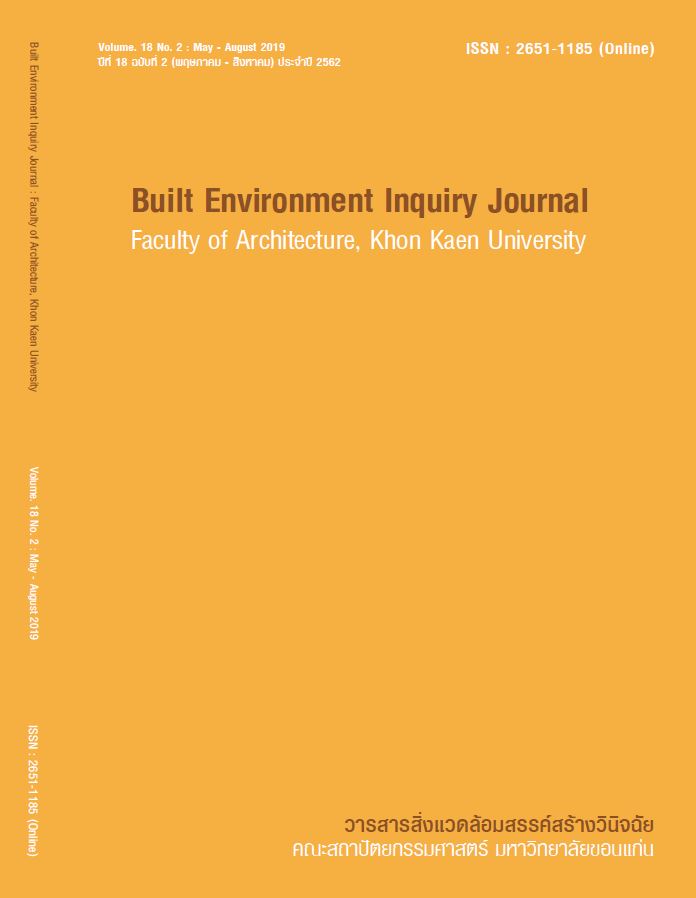แนวทางการปรับปรุงห้องตรวจผู้ป่วยนอกโรงพยาบาลมหาราชนครเชียงใหม่ตามแนวคิดสิ่งแวดล้อมเพื่อการเยียวยา
DOI:
https://doi.org/10.14456/bei.2019.8คำสำคัญ:
ความพึงพอใจ, ผู้ใช้บริการ, ห้องตรวจโรค, สิ่งแวดล้อมเพื่อการเยียวยาบทคัดย่อ
งานวิจัยนี้เพื่อเสนอแนวทางการปรับปรุงสิ่งแวดล้อมของโรงพยาบาล เพื่อตอบสนองความพึงพอใจของผู้ใช้บริการ ด้วยวิธีการสำรวจความพึงพอใจของผู้ใช้บริการทีมีต่อสิ่งแวดล้อมในห้องตรวจอายุรกรรม โรงพยาบาลมหาราชนครเชียงใหม่ และนำมาสังเคราะห์เป็นแบบจำลองปัจจัยองค์ประกอบของสิ่งแวดล้อมที่มีอิทธิพลต่อความพึงพอใจ โดยการวิเคราะห์องค์ประกอบเชิงยืนยัน ผ่านกลุ่มตัวอย่างผู้ใช้บริการภายในพื้นที่ตรวจอายุกรรม 300 คน เป็นการสุ่มแบบเจาะจง ใช้แบบสอบถามเพื่อวัดระดับความพึงพอใจ คำถามทุกข้อมีค่าความเชื่อมั่น สามารถนำไปใช้งานได้ ผลการวิจัยพบว่าปัจจัยสิ่งแวดล้อม 5 ด้าน 1) ความเป็นส่วนตัว (Factor Loading=0.41) 2) ความสะดวกสบาย (Factor Loading=0.38) 3) การควบคุมสิ่งแวดล้อม (Factor Loading=0.29) 4) สิ่งแวดล้อมที่ช่วยลดข้อผิดพลาด (Factor Loading=0.27) 5) ความปลอดภัย (Factor Loading=0.26) ปัจจัยทั้งหมดทดสอบความสอดคล้องของแบบจำลองด้วยการวิเคราะห์องค์ประกอบเชิงยืนยัน พบว่าแบบจำลองมีความสอดคล้องกับข้อมูลเชิงประจักษ์ CMIN/df=1.027<3.0, CFI=0.998>0.90, GFI=0.933>0.90, AGFI=0.906>0.95, RMSEA=0.009<0.08, NFI=0.927>0.90, RMR=0.028<0.08 แสดงว่าองค์ประกอบทั้ง 5 ด้าน สามารถอธิบายความพึงพอใจของผู้ใช้บริการที่มีต่อสิ่งแวดล้อมได้ ปัจจัยความเป็นส่วนตัว มีค่าน้ำหนักมากที่สุด ปัจจัยย่อยที่บ่งชี้จึงควรถูกเลือกให้ความสำคัญลำดับแรกในการปรับปรุง ส่วนปัจจัยหลักอื่น ๆ และปัจจัยย่อยที่บ่งชี้ ควรให้ความสำคัญรองลงมาตามค่าน้ำหนักของผลการวิเคราะห์ เพื่อเป็นแนวทางปรับปรุงสิ่งแวดล้อมในห้องตรวจ
เอกสารอ้างอิง
Berg, A.E. (2005). Health impacts of healing environments: A review of evidence for benefits of nature, daylight, fresh air, and quiet in healthcare settings. Groningen, Netherlands: Wageningen University.
Bloemberg, F.C., Juritsjeva, A., Leenders, S., Scheltus, L., Schwarzin, L., Su, A., et al. (2009). Healing environments in radiotherapy. Wageningen University, Groningen, Netherlands.
Booker, J.M., & Roseman, C. (1995). A seasonal pattern of hospital medication errors in Alaska. Psychiatry Research, 57(1995), 251-257.
Buchanan, T.L., Barker, K.N., Gibson, J.T., Jiang, B.C., & Pearson, R.E. (1991). Illumination and errors in dispensing. American journal of hospital pharmacy, 48(10), 2137-45.
Buckley, T.C., Blanchard, I.B., & Hickling, E.J. (1998). A confirmatory factor analysis of posttraumatic stress symptoms. Behaviour Research and Therapy, 36(11), 1091-1099.
Burton, E., & Torrington, J. (2007). Designing environments suitable for older people. CME Journal Geriatric Medicine, 9(2), 39-45
Dijkstra, K. (2009). Understanding healing environments: effects of physical environmental stimuli on Patients (Unpublished doctoral dissertation). University of Twente, Enschede, Netherlands.
Foss, K.R., & Tenholder M.F. (1993). Expectations and needs of persons with family members in an intensive care unit as opposed to a general ward. South Medical Journal, 86(4), 380-384.
Frumkin, H. (2001). Beyond toxicity: Human health and the natural environment. American College of Preventive Medicine, 20(3), 234-240.
Hair, J.F., Anderson, R.E., Tatham, R.L., & Black, W.C. (1998). Multivariate data analysis. Upper Saddle River, NJ: Prentice-Hall.
Hendrich, A., Fay, J., & Sorrells, A. (2004). Effects of acuity-adaptable rooms on flow of patients and delivery of care. American Journal of Critical Care, 13(1), 35-45.
Hilary, D., Little, J., Niemann, E., Camgoz, N., Steadman, G., Hill, S., et al. (2006). Colour and lighting in hospital design. Optics & Laser Technology, 38(4-6), 343–365.
Hilton, B.A. (1985). Noise in acute patient care areas. Research in Nursing and Health, 8, 283-291.
Huisman, E.R.C.M., Morales E., Van Hoof J., & Kort, H.S.M. (2012). Healing environment: A review of the impact of physical Environmental factors on users. Building and Environment, 58, 70-80.
Jenjapoo, T., & Waroonkun, T. (2015). Guideline for improving and creating healing environment in Maharaj Chiang Mai Hospital by adopting users' s perspective. Built Environment Research Associates Conference, 6, 348-355.
Lewy, A.J., Bauer, V.K., Cutler, N.L., Sack, R.L., Ahmed, S., Thomas, K.H., et al. (1998). Morning vs. evening light treatment of patients with winter depression. Archive of General Psychiatry, 55(10), 890-6.
Jonas, W.B., & Chez, R.A. (2004). Toward optimal healing environments in health care. Altern Complement Med, 10(Suppl 1), S1-6.
Joseph, A. (2006). Impact of light on outcomes in healthcare settings. Concord, CA: The Center for Health Design.
Maharaj Nakorn Chiang Mai Hospital. (2018). sathiti phūpūai khao rap kān raksā thī rōngphayābān mahārāt Chīang Mai pī sō̜ngphanhārō̜ihoksipʻet. (In Thai) [Statistics of patients admitted at Maharaj Chiang Mai Hospital, 2018]. Retrieved from https://www.med.cmu.ac.th/hospital/medrec/2011/index.php?option=com_content&view=category&id=130&Itemid=589&limitstart= 0
Menegazzi, J.J., Paris, P.M., Kersteen, C.H., & Trautman, D.E. (1991). A randomized controlled trial of the use of music during laceration repair. Annuals of Emergency Medicine, 20, 348-250.
Mill, R.C. (2002). A comprehensive model of customer satisfaction in hospitality and tourism: Strategic implications for management. International Business & Economics Research Journal, 1(6), 7-18
Mlinek, E.J. & Pierce, J. (1997). Confidentiality and privacy breaches in a university hospital emergency department. Academic Emergence Medicine, 4(12), 1142-6.
Panagopoulou, P., Filioti, J., Petrikkos, G., Giakouppi, P., Anatoliotaki, M., Farmaki, E., Kanta,. A., Apostolakou, H., Avlami, A., Samonis, G., & Roilides, E. (2002). Environmental surveillance of filamentous fungi in three tertiary care hospitals in Greece. Journal of Hospital Infection, 52(3), 185-191.
Preiser, W. (1994). Built environment evaluation: Conceptual basis, benefits and uses. Journal of Architectural and Planning Research, 11(2), 92-107.
Rasmanis, G., Blomkvist, V., Ulrich, R., Eriksen, CA., & Theorell, T. (2005). Influence of intensive coronary care acoustics on the quality of care and physiological state of patients. International Journal of Cardiology. 98(2), 267–270.
Ryherd, E.E., Waye, K.P., & Ljungkvist, L. (2008). Characterizing noise and perceived work environment in a neurological intensive care unit. Journal Acoustic Social American, 123(2), 747–56.
Stamps, E. (2007). Mystery of environmental mystery effects of light, occlusion and depth of view.
Environment and Behavior, 39(2), 165-197.
Taweekun, J., & Tantiwichien, A. (2013). Thermal comfort zone for Thai people. Scientific Research Engineering, 23(5), 525-529.
Ulrich, R.S. (1991). Effects of interior design of wellness: Theory and recent scientific research. Journal Health Care Interior Design, 3(1), 97-109.
Ulrich, R.S. (1999). Effects of gardens on health outcome theory and research. In Marcus, C.C. & Barnes, M. (Eds.). Healing gardens. Therapeutic benefits and design recommendations (pp.37-42). New York, NY: John Wiley & Sons.
Verderber, S., & Reuman, D. (1987). Windows, views, and health status in hospital therapeutic environments. Journal of Architectural and Planning Research, 4(2), 120-133.
Waroonkun, T. (2018a). The environmental factors affecting service satisfaction of community hospital.
Journal of Design and Built Environment, 18(1), 19-28.
Journal of Design and Built Environment. (2018b). Comparison of outpatient satisfaction measures across hospitals built to a Thai
standard design. Asian Social Science, 14(12), 255-265.
Wong, S., Glennie, K., Muise, M., Lambie, E., & Meagher, D. (1981). An exploration of environmental
variables and patient falls. Dimension in Health Service, 58(6), 9-11.
ดาวน์โหลด
เผยแพร่แล้ว
รูปแบบการอ้างอิง
ฉบับ
ประเภทบทความ
สัญญาอนุญาต
ทัศนะและข้อคิดเห็นของบทความที่ปรากฏในวารสารฉบับนี้เป็นของผู้เขียนแต่ละท่าน ไม่ถือว่าเป็นทัศนะและความรับผิดชอบของกองบรรณาธิการ




